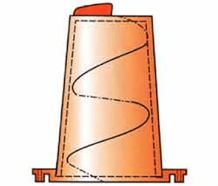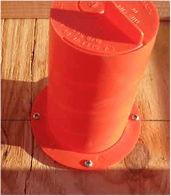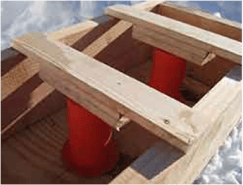The fastest and most cost efficient way to make Handrail Post holes is with correct use of EZ Sleeves. Set properly they can save countless man hours and expense.
Steel fabricators and erectors are well aware of the time required for the alternative method, core drilling. Not only is it much more time consuming, it can create additional expenses such as;
- The time to properly drill even a 3” diameter hole can be as much as 10 minutes and that is providing no impediments are met.
- Core drills themselves are expensive and are badly damaged when they inadvertently strike rebar or stones.
- Expenses are also incurred in other areas of the job when delays are created because core drilling runs longer than expected or additional manpower is required causing shortages elsewhere.
In a recent major water treatment plant project here in New York City we had a contractor use 300 of the large EZ Sleeves. These measure 4” diameter at the top, and are 12” deep. To get a perspective on how much cutting is required the circumference of a 4” wide circle is 12.56”. Times the 300 holes they required that equals 314’ of concrete 12” thick.
To see the EZ Sleeve Catalog Listings and more information, click here
The only objection we come across to using EZ Sleeves is coordinating the placement prior to the concrete pour. Obviously, if the steel handrail posts don’t align with the holes, the holes are not only useless but actually create more work.

One common problem in EZ Sleeve placement is the concrete contractor is not skilled in this type of work but more importantly does not have a vested interest in setting the EZ Sleeves correctly. Some fabricators have worked with the same concrete people long enough that they have trained them on accurate placement and can depend on it. In other cases the steel fabricator places the EZ Sleeves themselves. If time allows the safest way it to set the Sleeves and wait until after the concrete is set, then field measure and fabricate to exact locations.
Another issue with locating the EZ Sleeves is securing them so they withstand the concrete pour. The photo to the right shows the how the sleeve snaps securely into the separate base, which has holes for securing with screws into the plywood form, or longer spikes if the substrate is compact dirt or gravel.
 Another way to secure the EZ Sleeve is to brace it from the top. Wooden cross braces attach to the side forms and can be adjusted for height. While this will hold the sleeve more firmly in place, the cross braces will block the mason’s ability to trowel after the pour. They require some patience and cooperation on the part of the mason to pour carefully, then when the concrete is at full depth remove the cross braces and trowel carefully around the EZ Sleeve.
Another way to secure the EZ Sleeve is to brace it from the top. Wooden cross braces attach to the side forms and can be adjusted for height. While this will hold the sleeve more firmly in place, the cross braces will block the mason’s ability to trowel after the pour. They require some patience and cooperation on the part of the mason to pour carefully, then when the concrete is at full depth remove the cross braces and trowel carefully around the EZ Sleeve.





